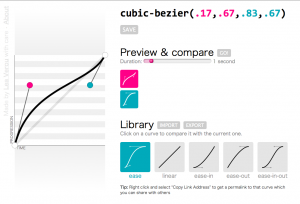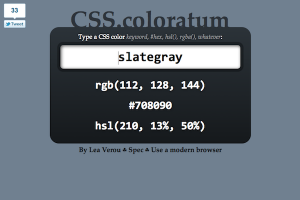 I wrote this script while at the airport travelling to Oslo and during the Frontend 2011 conference. I think it’s amazing, and it makes authoring CSS3 a pleasure.
I wrote this script while at the airport travelling to Oslo and during the Frontend 2011 conference. I think it’s amazing, and it makes authoring CSS3 a pleasure.
Read my announcement about it on Smashing Magazine.
Hope you like it!
 I wrote this script while at the airport travelling to Oslo and during the Frontend 2011 conference. I think it’s amazing, and it makes authoring CSS3 a pleasure.
I wrote this script while at the airport travelling to Oslo and during the Frontend 2011 conference. I think it’s amazing, and it makes authoring CSS3 a pleasure.
Read my announcement about it on Smashing Magazine.
Hope you like it!
I’m writing this blog post while eating some of the amazing Lindt chocolates I got for free 10 days ago at Frontend conference in Zurich. But it wasn’t a good experience only because of them!
 A few days ago, I had a talk at a conference in Zurich (I’m going to write more about it in another post). The talk was about “10 things you might not know about CSS3”. The first of those things was how you can do bouncing transitions with cubic-bezier() instead of an easing keyword. As usual, my slides included a few live demos of the functionality, in which I edited the cubic-bezier() parameters and the audience could see the transition produced.
A few days ago, I had a talk at a conference in Zurich (I’m going to write more about it in another post). The talk was about “10 things you might not know about CSS3”. The first of those things was how you can do bouncing transitions with cubic-bezier() instead of an easing keyword. As usual, my slides included a few live demos of the functionality, in which I edited the cubic-bezier() parameters and the audience could see the transition produced.
However, in the case of cubic-bezier() that’s not enough. No matter how much you see someone changing the parameters, if you don’t picture it in a 2D plane, it’s very hard to understand how it works. So, the night before, I searched for a tool I could use to show them how bezier curves are formed. I found plenty, but all of them restricted the the coordinates to the 0-1 range. I’m not sure if the cause is ignorance about the spec changes or that Webkit hasn’t caught up with those changes yet (but it will, soon). The only one that supported values out of range was this one from the Opera Dragonfly developers, but I found it kinda impossible to adapt.
For my talk, I tried to adapt one of them but it was late so I gave up after a while and ended up just showing them a screenshot. And the day after the talk, I started adapting this to my needs (ever tried coding at a conference? It’s awesome, you get to ask questions from very knowledgeable people and ger replies straight away). And then I started cleaning up the code, changing how it worked, adding features. At this point, I think the only thing that’s left from that tool is …the HTML5 doctype. After 3-4 days, I finished it, and got it its own domain, cubic-bezier.com (I was surprised it was still free).
Lots of things:
Given that this tool is not only for developers, but for badass developers that care about stuff like cubic-bezier(), I think I can safely assume they’re using a top notch browser. So, I went crazy with using cool modern stuff:
So far, I’ve tested it in modern versions of Chrome, Firefox, Opera and Safari and it seems to work. I haven’t tested it in IE10 (too lazy to open vm), although I want it to work there too, so if it doesn’t let me know. 🙂
Enjoy! cubic-bezier.com
steps() is a relatively new addition to the CSS3 animations module. Instead of interpolating the values smoothly, it allows us to define the number of “frames” precisely. So I used it to create headers that have the well-known animated “typing effect”:
As you can see, the number of characters is hardcoded in the steps() function, but that’s the only place. Everything else is totally flexible. Apart from the font: It has to be monospace, so that every character has the same width.
Also, this particular way requires a solid background and an extra <span>. You can avoid these limitations by directly animating the width of the heading itself, but this requires a fixed target width hardcoded in the animation, so 2 things that need to be changed for every heading:
If you’re having trouble understanding how it works, take a look at this simpler example, with just the cursor.
Gecko (Firefox) and Webkit only at the moment, since other engines haven’t implemented CSS animations yet. However, both examples degrade very gracefully in other browsers (IMO at least).
 Whenever I wanted to convert a CSS named color to RGB, I used to open the CSS3 colors spec in a new tab, search in the page and copied the values. Every time it felt even more tedious. I didn’t want to search in long tables, I wanted to type the color somewhere and get the values back, in an easy to copy format. So, after yet another color lookup earlier today, I decided to scratch my own itch and do it myself.
Whenever I wanted to convert a CSS named color to RGB, I used to open the CSS3 colors spec in a new tab, search in the page and copied the values. Every time it felt even more tedious. I didn’t want to search in long tables, I wanted to type the color somewhere and get the values back, in an easy to copy format. So, after yet another color lookup earlier today, I decided to scratch my own itch and do it myself.
Of course, I didn’t plan to include a whole database of CSS colors in the website. My idea was much simpler: Use the named color to draw a rectangle in a <canvas> and then read the R,G,B values through ctx.getImageData().
I got the core functionality done in under 10 minutes, so I started adding stuff. I added a hex and HSL representation, I used canvas.toDataURL() to get a data URI of the rectangle and use it as a dynamic favicon*, I made the colors sharable and bookmarkable by using an old-fashioned hash. Also, I realized it actually supports any CSS supported color represenation by design, not just named colors.
Regarding the color conversions themselves, I took extra care to avoid redundancy. So values < 1 don’t have leading zeroes (.5 instead of 0.5) and when the hex color is in the format #xxyyzz it gets converted to #xyz. When it’s an RGBA color, it still converts it to hex, since those values will be supported in CSS4.
Since it’s for developers, I didn’t bother at all with fallbacks.
Cool stuff used:
The reason the input’s border appears weird on Webkit is this long standing Webkit bug. Also, for some reason my nice dynamic favicons don’t display on Firefox, although they display fine in Webkit and Opera.
*Thanks to @milo for giving me the idea of using a dynamic favicon
For ages, we couldn’t utilize the sibling combinators (~ and +) to ease the pain of creating star rating widgets, because of this stupid Webkit bug. Nowadays, not only it’s fixed, but the fix has already propagated to Chrome and Safari 5.1. So, we can at least use the sibling combinator to make coloring the stars easier.
But can we use no JavaScript for a rating widget and make it just with CSS?
Actually, we can. By adapting Ryan Seddon’s technique for custom radio buttons with CSS, we can turn a series of radio buttons into stars that change colors (for the purposes of this demo they’re just unicode characters that change colors, but in your case they may as well be images) and use the sibling combinator to color the previous stars. A series of radio buttons is what many people use as a star rating widget fallback anyway, so the markup required is not necessarily more than usual. The only thing that needs to be done differently is their reverse ordering: The highest ratings need to go first, due to the way CSS3 selectors work (this limitation might be removed in CSS4, but that’s a long way ahead).
Of course, you’d still need JS to attach an event handler if you want the votes to be registered through AJAX, but that’s not part of the rating widget per se (it could still work as part of a regular form).
What’s best is that it’s fully keyboard accessible (focus and then use keyboard arrows) and screen reader accessible (although VoiceOver will also pronounce the generated stars, but that won’t happen if you use images instead of unicode stars). I’m guessing it could become even more accessible with proper ARIA, but I’ll leave that as an exercise to the commenter 😀
In browsers that don’t support :checked (essentially only IE < 9), it degrades to a series of radio buttons (haven’t verified that it does, but it should do).
So, here it is:
Legal note, for those who need it: This code is MIT licensed.
Today I stumbled upon this tutorial, which from the screenshot, looked very interesting. So, I read on, and to my horror I noticed the author suggesting some questionable practices, the worst of which was using 3 HTML elements for every tag, including nonsense markup like <span class="circle"></span>.
So, I thought I’d take a chance at trying to recreate this effect without any extra markup. And it turned out to be quite easy, although using CSS gradients limits browser support a bit (IE10, Firefox 3.6+, Chrome, Safari 5.1).
They have the same disadvantage as the originals: They depend on the background color. However, unlike the originals, they come at less code, they’re scalable without changing a million values (as shown in the “bigger” section) and of course, no extra markup.
You can see the results in the fiddle below:
Disclaimer: webdesign tuts+ occasionally has some nice tutorials. I didn’t write this post to attack them in any way.
Which is really sad, because SVG is awesome. It lets you do what CSS gradients do and much more, in quite a small filesize, as it’s just text too. However, the browser needs to generate a DOM for every SVG graphic, which results in sluggishness.
Mouse over the 2 divs. They both use a spotlight effect that’s dynamically updated according to the position of the mouse cursor. One of them does it with an SVG (through a data URI), the other one through a CSS radial gradient.
The test only works in Chrome, Firefox nightlies and perhaps IE10 (haven’t tested in Windows). Why? Because Opera doesn’t support radial gradients yet (however you can see how slow SVG is in it too), and Firefox before the nightlies used to have a bug with gradients in SVG through data URIs. Also, jsFiddle seems not to work in Webkit nightlies for some reason, but I’m too lazy right now to make a self-hosted test case.
Thanks a lot to Christian Krebs (lead developer of Opera Dragonfly) who inspired these tests after a discussion we had today regarding CSS gradient performance.
Edit: According to some commenters, they’re the same speed on Windows and Linux, so it could be an OSX issue. The only way to know for sure is to post more results, so go ahead and post yours!
Also, some commenters say that this is not a fair comparison, because it generates a new SVG every time. I have several arguments to reply to this:
In case you haven’t noticed, in addition to my talk at Fronteers 2011, I’ll also be holding a full day workshop the day before the conference. The title of that workshop is “CSS3 for developers” and I wanted to explain a bit what it’s going to be about and why I chose to target web developers only.
We all know about the proprietary (and imho, horrible) -webkit-box-reflect. However, you can create just as flexible reflections in Firefox as well, by utilizing -moz-element(), some CSS3 and Firefox’s capability to apply SVG effects to HTML elements. And all these are actually standards, so eventually, this will work in all browsers, unlike -webkit-box-reflect, which was never accepted by the CSS WG.
First and foremost, have a look at the demo:
::after pseudoelement with the same dimensions and a position of being right below our original element.‑moz-element(#element-id) and no content.transform: scaleY(‑1);translateY(10px)opacity of around 0.3-0.4mask CSS property. In this demo, the SVG is external, but it could be a data URI, or even embedded in the HTML.Credits: Thanks to Christian Heilmann for helping me debug why SVG masks for HTML elements weren’t originally working for me.